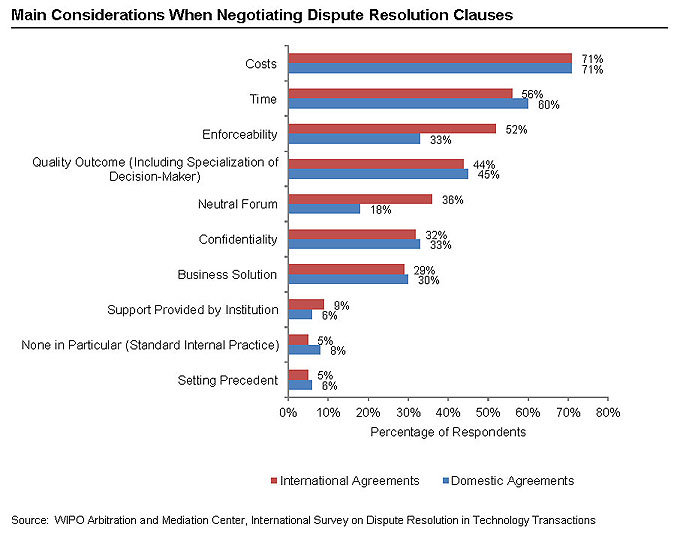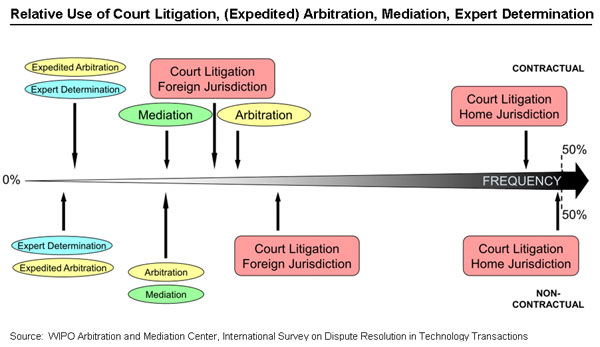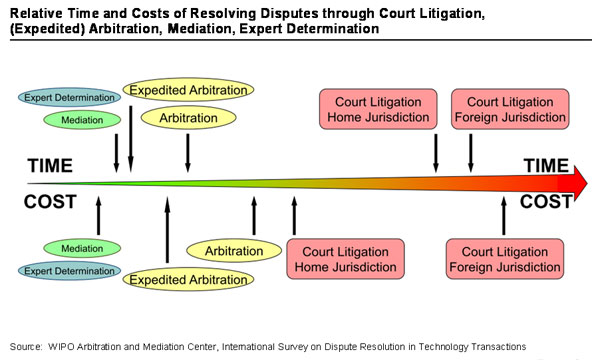Full Report
Executive Summary
Objective
The World Intellectual Property Organization’s (WIPO) Arbitration and Mediation Center (WIPO Center) designed the International Survey on Dispute Resolution in Technology Transactions (Survey) to assess the current use in technology-related disputes of Alternative Dispute Resolution (ADR) methods as compared to court litigation, including a qualitative evaluation of these dispute resolution options.
The results of this Survey provide a statistical basis to identify trends in the resolution of technology related disputes. Best practices emerge from the Survey which may help guide intellectual property (IP) stakeholders in their dispute resolution strategies and this Report concludes with a number of observations relevant to such strategies. The Survey Respondents’ needs identified also help inform the WIPO Center’s ADR services.
The Survey has been developed with the support of the International Association for the Protection of Intellectual Property (AIPPI), the Association of University Technology Managers (AUTM), the Fédération Internationale des Conseils en Propriété Industrielle (FICPI) and the Licensing Executives Society International (LESI) in collaboration with in-house counsel and external experts in technology disputes from different jurisdictions and business areas. Their collective experience with disputes is reflected in the content, scope and structure of the questionnaire; they also assisted in its distribution.
Respondents and Results
The core findings of the Survey are as follows.
1. Survey Respondents
393 Respondents from 62 countries completed the Survey. 63 Respondents from 28 countries complemented their written responses with a telephone interview.
Respondents are based in Europe, North America, Asia, South America, Oceania, the Caribbean, Central America and Africa.
Respondents are law firms, companies, research organizations, universities, government bodies or are self-employed. Respondents range from entities of 1-10 employees to entities of more than 10,000 employees. Respondents are active in different business areas, including pharmaceuticals, biotechnology, IT, electronics, telecom, life sciences, chemicals, consumer goods and mechanical.
2. Technology-related Agreements Concluded in the Past Two Years
Of the types of agreements listed in the Survey, Respondents concluded most frequently non disclosure agreements (NDA), followed by assignments, licenses, agreements on settlement of litigation, research and development (R&D) agreements and merger and acquisition (M&A) agreements.
The subject matter of such agreements related more often to patents than to know-how or copyright.
More than 90% of Respondents concluded agreements with parties from other jurisdictions. 80% of Respondents concluded patent-related agreements with parties from other jurisdictions on technology patented in at least two countries.
The choice of applicable law made in these agreements was influenced by the location of Respondent headquarters and the primary place of operations.
3. Agreements Leading Most Often to Disputes
Respondents were asked to estimate what percentage of the technology-related agreements they concluded led to disputes. As such agreements, the questionnaire listed, in this order, NDAs, R&D agreements, licenses, settlement agreements, M&A agreements and assignments.
While, overall, disputes occurred in relation to some 2% of Respondents’ technology-related agreements, more than half of Respondents stated that out of the agreements listed in the Survey less than 1% of licenses, R&D agreements, NDAs, settlement agreements, assignments and M&A agreements led to disputes. On the other hand, 7% of Respondents stated that more than 10% of their licensing agreements led to disputes.
Indeed, among technology-related agreements, licenses most frequently give rise to disputes (25% of Respondents). R&D agreements rank second (18% of Respondents), followed by NDAs (16%), settlement agreements (15%), assignments (13%), and M&A agreements (13%).
4. Choice of Dispute Resolution Clauses
94% of Respondents indicated that negotiating dispute resolution clauses forms part of their contract negotiations.
Court litigation was the most common stand-alone dispute resolution clause (32%), followed by (expedited) arbitration (30%) and mediation (12%). Mediation is also included where parties use multi-tier clauses (17% of all clauses) prior to court litigation, (expedited) arbitration or expert determination.
Respondents generally perceived a trend towards out-of-court dispute resolution mechanisms.
The choice of arbitral institution broadly corresponds to the location of Respondent headquarters.
Cost and time are the principal considerations for Respondents when negotiating dispute resolution clauses, both in domestic and international agreements.
For international agreements, Respondents placed a higher value on enforceability and forum neutrality than they did for domestic transactions.
Enforceability also ranked as a motivating factor among Respondents using court litigation and arbitration clauses. Finding a business solution was an important factor for Respondents choosing mediation.

5. Types of Technology Disputes and Party Objectives
For contractual and non-contractual disputes, patent issues arose nearly twice as often as copyright or know-how issues.
The main objectives of claimant parties in patent disputes were to obtain damages/royalties (78%), a declaration of patent infringement (74%), and/or injunctions (53%).
The main objectives of respondent parties in patent disputes were a declaration of patent invalidity (73%), a negative declaratory judgment (33%), and/or a declaration of patent infringement (33%).
6. Mechanisms Used to Resolve Disputes: Type, Time and Costs
6.1. Type
Broadly consistent with the above findings concerning the choice of dispute resolution clauses, the most common mechanism used to resolve technology disputes was court litigation in Respondents’ home jurisdiction, followed by court litigation in another jurisdiction, arbitration, mediation, expedited arbitration and expert determination.
29% of Respondents indicated that they had submitted a dispute to mediation before or during court litigation involving contractual patent, copyright and/or know-how issues.

6.2. Time and Costs
Respondents indicated that they spent more time and incurred significantly higher costs in court litigation than in arbitration and mediation.
Respondents estimated that court litigation in their home jurisdiction took on average approximately 3 years and court litigation in another jurisdiction took on average 3.5 years.
Respondents estimated that legal costs incurred in court litigation in their home jurisdiction amounted on average to USD 475,000, and legal costs of court litigation in another jurisdiction amounted to slightly over USD 850,000.
Respondents indicated that mediation took on average 8 months, and 91% of Respondents stated that costs of mediation typically did not exceed USD 100,000.
Respondents indicated that arbitration took on average slightly more than 1 year and cost on average slightly over USD 400,000.
Apart from monetary amounts, 25% of Respondents identified management time of business executives and wasted time of other participants in proceedings, lost productivity and lost business opportunities as costs incurred.

Further Information
| Geneva | Singapore |
|---|---|
|
WIPO Arbitration and Mediation Center |
WIPO Arbitration and Mediation Center Maxwell Chambers 28 Maxwell Road #02-14 Singapore 069120 T +65 6225 2129 F +65 6225 3568 arbiter.mail@wipo.int |